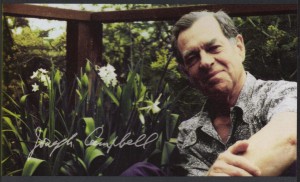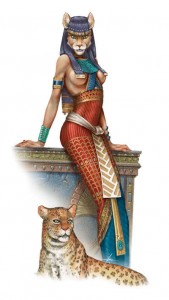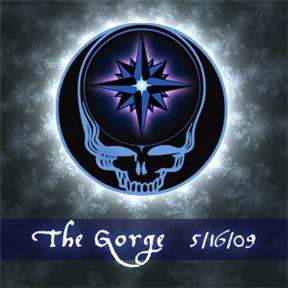Atomic Mobius Machine in Mariposa- The Miner’s Inn 4-18-2008
Chris Roberts, Ross Artese, Vincent Mitchell, Stephen Saunders
Joseph Campbell and the Grateful Dead
“The Deadheads are doing the dance of life and this I would say, is the answer to the atom bomb.”
“I had a marvelous experience two nights ago. I was invited to a rock concert. (laughter in the audience) I’d never seen one. This was a big hall in Berkeley and the rock group were the Grateful Dead, whose name, by the way, is from the Egyptian Book of the Dead. And these are very sophisticated boys. This was news to me.
Rock Music has never seemed that interesting to me. It’s very simple and the beat is the same old thing. But when you see a room with 8,000 young people for five hours going through it to the beat of these boys… The genius of these musicians- these three guitars and two wild drummers in the back… The central guitar, Bob Weir, just controls this crowd and when you see 8,000 kids all going up in the air together… Listen, this is powerful stuff! And what is it? The first thing I thought of was the Dionysian festivals, of course. This energy and these terrific instruments with electric things that zoom in… This is more than music. It turns something on in here (the heart). And what it turns on is life energy. This is Dionysus talking through these kids. Now I’ve seen similar manifestations, but nothing as innocent as what I saw with this bunch. This was sheer innocence. And when the great beam of light would go over the crowd you’d see these marvelous young faces in sheer rapture- for five hours! Packed together like sardines! Eight thousand of them! Then there was an opening in the back with a series of panel windows and you look out and there’s a whole bunch in another hall, dancing crazy. This is a wonderful fervent loss of self in the larger self of a homogeneous community. This is what it is all about!
It reminded me of Russian Easter. Down in New York we have a big Russian Cathedral. You go there on Russian Easter at midnight and you hear Kristos anesti! Christ is Risen! Christ is Risen! It’s almost as good as a rock concert. (laughter) It has the same kind of life feel. When I was in Mexico City at the Cathedral of the Virgin of Guadalupe, there it was again. In India, in Puri, at the temple of the Jagannath- that means the lord of the Moving World- the same damn thing again. It doesn’t matter what the name of the God is, or whether its a rock group or a clergy. It’s somehow hitting that chord of realization of the unity of God in you all, that’s a terrific thing and it just blows the rest away.” —Joseph Campbell (1986)
—————————————
“The next great, proud moment was when Mickey Hart and Bob Weir come along and tell me I’ve helped them. Well, I never — the rock music never appealed to me at all. It was largely monotonous, it seemed to me. Then they invited Jean [his wife] and me to an event in Oakland that just became a dance revelation. I got something there that made me note that this is magic. And it’s magic for the future. . .
They hit a level of humanity that makes everybody at one with each other. It doesn’t matter about this race thing, this age thing, I mean, everything else dropped out. The wonderful thing was, compared to the Hitler rallies that you see in the film that were used to a political purpose, here it was just the experience of the identity of everybody with everybody else.
I was carried away in a rapture. And so i am a Deadhead now…” —Joseph Campbell, The Hero’s Journey
—————————————
” …it seemed to me we had the kind of awakening that the great religions first intended, and that somehow it involved everybody. There were kids there. There were old people there, and in other parts of the building there were people just dancing and dancing… we had a chance to awaken our hearts, unbound by any particular cultural or religious commitments to this group or that. It seemed to me, and I’m meaning this very seriously, a prime religious experience that transcended all the bondages and definitions of who and what we are that are the curse of the world today. This, I would say, is the answer to the atom bomb.” —Joseph Campbell speaking about watching Deadheads at a Grateful Dead Show
Super Beat Ensemble 3-6-11 track 1
This session features several regulars player to the SBE project, and it came out pretty interesting… YOU be the judge of that.
Stephen ‘Maji’ Saunders, percussion,keyboards,harmonica, vocals
Daniel Dominguez- Electric Guitar, Vocals
Featured Artists
Cort Stricker- Electric Guitar
Greg White- Trap Drums
Paul Chun- Bass Guitar, Vocals
SBE- Grateful Dead Instrumental Tribute- Fire On the Mountain
Fire on the Mountain,an instrumental jam by:
Cort Stricker = Lead/Rhythm Guitar
Stephen Saunders = Percussion,Samples
Danny Dominguez = Guitar Rhythm/2nd Lead,Vox
Joe R.= Drums
Vincent Mitchell = Bass,Synth
Cat Goddess Temple: Egypt Announces Find Of Ancient Temple
Marijuana and the Goddess
by Chris Bennet, illustrations by Ken Lee. Posted on Monday, August 31 1998 11:00:00 PM
http://www.cannabisculture.com/articles/1374.html
Holy pot has been smoked by Goddess worshippers since before history, and was first banned by those who sought to subjugate feminine spirituality

Part 5 of “When Smoke Gets in my I” a series on the history of cannabis and human consciousness.
In most ancient hunter-gatherer societies, women balanced the males’ supply of game with their collected harvest from the surrounding wilderness. Women therefore became the first to learn the secrets of plants, and how they propagated themselves.
This knowledge led to the development of agriculture, and the evolution from the animal totems of the hunter-gatherers to images of the Great Mother, who with proper worship produced her abundant harvest in the same way that women produced children.
Cannabis is among humanity’s oldest and most useful cultivated crops, and so it is not surprising to find that cannabis, in all its forms, has been intricately associated with Goddess worship in many cultures, throughout history.
Kali-Ma
The most ancient goddess still worshiped in the world today is the Indian Kali-Ma, the Mother of Life and Death. Her worship stretches back into pre-history, and is believed to predate that of her more well-known consort Shiva, the longest continually worshiped god on earth. Both Shiva and Kali are strongly associated with marijuana.
Kali is generally depicted with a girdle of human arms and a necklace of skulls, and represents the dark aspect of the goddess trinity of virgin-mother-crone. Both ancient and modern devotees of Kali partake of marijuana in various forms as a part of their worship.
Devotional ceremonies to Kali involve cannabis ingestion and ritual sex, which is directed at raising the Kundalini energy from the base of the spine up into the higher centres of the brain.
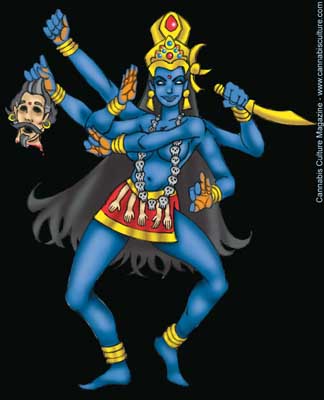
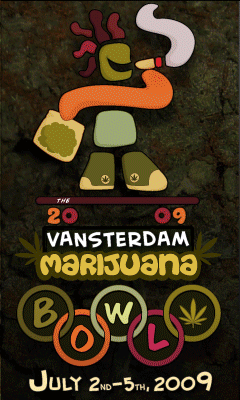
Other pot-goddesses
The worship of Kali, under various names, extended into the ancient Near East, and cannabis was also used by many of the worshippers of Kali’s ancient world counterparts.
Kali is the Hindu counterpart of the ferocious and sensual Canaanite goddess Anath, (part of a similar trinity with Ashera and Astarte)who is also described with “attached heads to her back, girded hands to her waist.”
In ancient Germany, marijuana was used in association with Freya, the slightly tamer Kali-like goddess of Love and Death.
Scythian Hempsters
It is generally accepted that it was the horseback-riding Scythians who spread the combination of cannabis and goddess worship throughout much of the ancient world.
Readers of part two in this series (CC#2) will remember that the Amazon-like Scythian women fought alongside their warrior mates, and that these “Hell’s Angels” of the ancient world were known to have used cannabis in funeral rites, doing so in veneration of their own variation of the Goddess Mother of Life and Death, Rhea Krona.
Showing cannabis’ strong ties with Scythian mythology, Rhea Krona came to reap her children in death with the scythe, an agricultural tool named for its Scythian origin, and originally designed for harvesting cannabis. This scythe image has survived through patriarchal times and into our modern day, with both Father Time and the Grim Reaper still carrying Rhea Krona’s ancient hemp-harvesting tool.
The Tree of Life
In a cave where an ancient urn was found that had been used by the Scythians for burning marijuana, there was also a massive felt rug, which measured 5 by 7 metres. The carpet had a border frieze with a repeated pattern of a horseman approaching the Great Goddess, who holds the Tree of Life in one hand and raises the other in welcome.
Imagery of the Goddess and the Tree of Life is also found amongst other cultures with whom the Scythians came into contact. Readers of part three in this series (CC#5) will remember that the ancient Canaanites and also Hebrews paid particular reverence to the Near Eastern Goddess Ashera, whose cult was particularly focussed around the use of marijuana.
According to the Bible itself, the ancient worshippers of Ashera included wise King Solomon and other biblical kings, as well as their wives and the daughters of Jerusalem. The Old Testament prophets often chastised them for “offering up incense” to the Queen of Heaven.
Like the imagery on the Scythian carpet, icons dedicated to Ashera also have depictions of a “sacred-tree”, most likely a reference to the cannabis that her followers grew and revered, using it as a sacrament, as a food and oil source, and also using the fibres in ritual weavings.
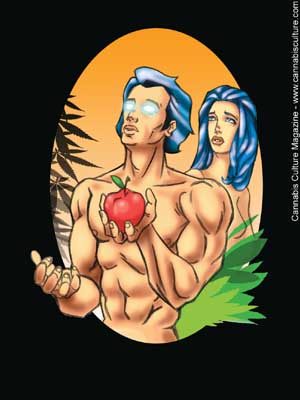
Eve: cultural hero
Among her other titles, Ashera was known as “the Goddess of the Tree of Life”, “the Divine Lady of Eden” and “the Lady of the Serpent”. Ashera was often depicted as a woman holding one or more serpents in her hands. It was Ashera’s serpent who advised Eve to disobey the male god’s command not to partake of the sacred tree.
The historical record shows that the Old Testament version of the myth of Eve, the serpent and the sacred tree was concocted as propaganda against pre-existing Goddess cults.
Originally, the outcome of the Eden myth was not tragic, but triumphant. The serpent brought wisdom, and after the magic fruit was eaten, Adam himself became a god. What was originally involved was probably a psychedelic sacrament, like the Elusian festival in Athens, in which the worshipper ate certain hallucinogenic foods and became one with the Mother Goddess Demeter.
Like the Tree of Life, the Tree of Knowledge was a symbol associated with the Goddess. The rites associated with her worship were designed to induce a consciousness open to the revelation of divine or mystical truths. In these rites cannabis and other magical plants were used, and women officiated as priestesses.
Roman Catholic Persecution
In early Christian times, the holy cannabis oil was ingested and used by many Gnostic Christian sects, in honour of the Queen of Heaven.
With the rise of one of the more harshly ascetic and anti-female Christian sects in Rome, and the subsequent development of the Roman Catholic Church, such groups were forced out of existence, along with most pagan religions and the cult of the Great Mother.
The new Church of Rome followed their Judaic predecessors in naming Eve (the representative of all women) the “Mother of Sin”, as well as demonizing magical plants.
Their violent purges of Goddess worship and magical plant use persisted into medieval times. It has been estimated that over a million female practitioners of the older Goddess religions were burned as “witches” for utilizing cannabis, mandrake, belladonna and other plants in their “flying ointments”.
Even medieval French heroine Joan of Arc was accused of using cannabis, mandrake and other plants in order to hear the voices which guided her, and this eventually led the church to commit her to the flames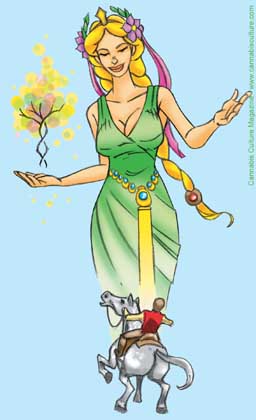
Marrying your Goddess
Similar to its use in the spiritual techniques of India, medieval European occult and alchemical masters used cannabis to aid in the “Marriage of the Sun and Moon” in the individual. The Sun and Moon represent the masculine and feminine aspects of the self.
Tantrik, Zoroastrian, Gnostic, Alchemical and occult literature all refer to “marrying your Goddess”, which means connecting an individual’s feminine and masculine aspects together into a unified force. This theme appears over and over again in medieval occult literature. Even the Gnostic Jesus states “when you make the male and female one and the same? then you will enter the kingdom.” (Gospel of Thomas)
Much like the woman’s liberation movement which has been taking place in our modern world, individual self completion requires a similar process to take place in our minds. The feminine aspect, or right cortex, becomes a full partner with the masculine aspect, or left cortex.
Marijuana use can greatly assist in this process. Is it any wonder then, that Shiva, the Lord of Bhang, was known as the god who was both man and woman? Or that the hashish eating Sufis, and later the American hippies, were both accused of being too feminine?
Love your mother
From the collected evidence it is clear that cannabis has been associated with worship of the Goddess since antiquity. Now, as we stand on the verge of a new millennia, in what seem to be the death throes of the patriarchy, it is as if the Goddess is once again reaching out her hand and offering her sacred Tree of Life to us in our time of collective need.
Like so many disobedient Eves, numerous female figures such as Elvy Mussika, Hilary Black, Mary Kane, Mountain Woman, The Holy Sisters of Hemp, Mama Indica, Brownie Mary and many others have decided to challenge the commandments of the male authorities and once again tempt us with the forbidden fruits of cannabis.
Indeed, it is likely not until we are once again free to enjoy all the sacred fruits of Mother Earth that the liberation of the feminine will fully take place, and we can restore Gaia, our planetary matriarch, back to health.
-|-
The androgynous nature of the human organism is re-emerging into consciousness in new ways that have evolved from past experience. We are learning to recognize and differentiate the opposites in our nature.
It makes no difference whether we call these opposites masculine and feminine, creative and receptive, knowledge and wisdom, competition and cooperation, explosion and implosion, or Logos and Eros. What is important, is that they be experienced in union as aspects of our own inner self. They are the self-renewing possibilities of our own individuality. Yoked together, they can fertilize each other to generate the creativity which is the potential of human beings.
The return of such female values as cooperation and forbearance is longed for in a world torn by war and threatened by nuclear disaster, poverty, disease and rape of the land. When the goddess of fertility is reunited with the god of consciousness, the renewed culture will have its conception.
? The Yoga of Androgyny, June Singer
-|-
Hymn To The Plants ? Rig Veda X.97.
Plants which as receptacles of light were born three ages before the Gods, I honour your myriad colors and your seven hundred natures.
A hundred, oh Mothers, are your natures and a thousand are your growths. May you of a hundred powers make whole what has been hurt.
Plants, as Mothers, as Goddesses, I address you. May I gain the energy, the light, the sustenance, your soul, you who are the human being.
Where the herbs are gathered together like kings in an assembly, there the doctor is called a sage, who destroys evil, and averts disease.
As they fell from Heaven, the plants said, “The living soul we pervade, that man will suffer no harm.”
The Herbs which are in the kingdom of the Moon, manifold with a hundred eyes, I take you as the best of them, for the fulfillment of wishes, as peace to the heart.
The plants which are queens of the Soma, spread over all the Earth, generated by the Lord of Prayer, may your energies combine within this herb.
-|-
How women are like pot.
There are some biological oddities which link cannabis with humans, especially the females of our species.
First, certain active compounds of marijuana have molecular resemblance to the female hormone estrogen. Possibly it is due to this aspect of cannabis’ genetic make-up that some growers have reported success with fertilizing their plants with birth control pills or menstrual fluid, the use of which as a ritual fertilizer goes back to the matriarchal period.
Of similar interest is that cannabis seeds contain rare gamma linoleic acid, found only in spirulina, two other rare seed oils, and human mother’s milk. As the tribal people of the world have always shown an incredible intuition when it comes to right use of plants, it is interesting to note that the Sotho women of South Africa make a mealy pap from hempseed to wean their babies off breast milk. ![]()
Recommended Reading:
The Chalice & the Blade, by Riane Eisler
A History of Religious Ideas, by Mircea Eliade
Ishtar Rising, by Robert Anton Wilson
The Woman’s Encyclopedia of Myths and Secrets, by Barbara Walker
The Ritual Use of Cannabis Sativa: A Historical Ethnographic Survey, by WA Emboden (in Flesh of the Gods: The Ritual Use of Hallucinogens, Peter Furst, Ed)
Chris Bennet is the author of Green Gold: Marijuana in Magic and Religion, and the forthcoming Sex, Drugs and Violence in the Bible.
The DEAD at the Gorge in Quincy Washington 5-16-09 MEN SMART WOMEN SMARTER
ALOT of back story on POT
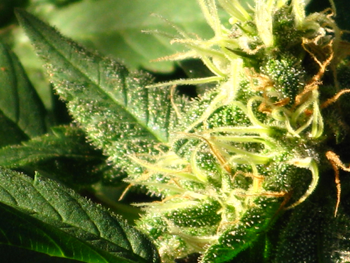
There is ample proof that indicates that man has been using marijuana since the pre-historic times. Normally, the use of marijuana by man is estimated to date back to about 10,000 years ago, but findings at a pre-historic village unearthed in Taiwan in 1972 indicates that the herb has been in use since time immemorial. Ruins of earthenware found in this pre-historic Taiwanese village sustained marks of hemp (a narcotic drug made from plant found in Asia that is smoked, chewed, eaten or drunk to produce a mild euphoric reaction) twines providing proof that marijuana has been used by men in this part of the world since the Stone Age.
According to the Chinese language, marijuana is known as ‘Ma’. It is an enduring aromatic plant that grows once a year and perhaps known to be the ‘mother’ of all civilizations depending on agriculture. For the ancient man, ‘Ma’ was not only a never ending source of food, but the herb also provided sturdy fiber for producing long-lasting ropes and cloth. In fact, while the pre-historic man in most other civilizations continued to hunt and collect food for survival, these two virtues of ‘Ma’ put China at the forefront by establishing an advanced agriculture-based industry. In addition to its medicinal, textile and other uses, marijuana seeds offer high quantities of protein, B vitamins and essential amino acids. Thus, it is little surprising that these marijuana seeds have served as the second or third most essential resource of foodstuff in China for thousands of years.
It is interesting to note that excavations in the ruins of the Nile civilization in Egypt have revealed that the people there used marijuana for its medicinal properties since as early as the 16th century. Similarly, diggings at the primeval Hebrew civilization sites also prove that they used marijuana as a therapy during childbirth since long before the birth of Jesus Christ. Therefore, there is little doubt that the multifaceted properties and uses of marijuana have demonstrated to be a priceless reserve for the continued existence of the Chinese culture since days immemorial to the present.
Significantly, the most primitive substance that was recognized as fabric from the hemp was discovered in a primeval burial site said to belong to the Chou Dynasty (1122-1249 B.C.) in China. This discovery of this hemp fabric corroborated the numerous mentions in history regarding the significance of help in ancient China. According to the instructions in the Book of Rites (compiled in 200 B.C.), the mourners in China were required to wear clothes made from hemp fabric as this was considered to be a way to show respect to the departed soul. Incidentally, this ancient tradition is still followed in several parts of China even today.
However, what is of greater significance is the innovation of the hemp paper by the Chinese as early as 200 B.C. This invention not only helped the early Chinese to maintain all their records, but also enabled them to perform an elementary task – run the government in a methodical manner. The Chinese were successful in keeping in secret the invention as well as the process of making paper from hemp fiber for as long as 900 years, eventually paper manufactured from hemp became crucial for the speedy progress of all the civilizations across the world. Significantly, several thousand years before paper made from hemp became a crucial aspect of the European civilizations, China – a nation historically known to the world as the land of hemp and mulberry – had advanced by leaps and bounds in utilizing the therapeutic and industrialized use of ‘Ma’ or the marijuana.
Medicine practitioners in early China carved the hemp stems into decorative snake-like figures and believed that they acted as good luck charm and helped in getting rid of devils or evil spirits which were considered to be the basis of all corporal ailments. The healing process of these medicine men too was peculiar. They tried to cure all types of diseases by thumping the headboards of the patients’ beds with the flamboyant mysterious hemp stalks while narrating magic charms and invocations to drive away the demons. In Japan, the Shinto priests also performed a comparable ritual by using a small baton conjoined with hemp fibers that are not dyed. This was done with the belief that the serenity of the white hemp stalks would be more effectual in getting rid of the evil spirits and hence the diseases. While modern day science as well as progressive-thinking masses may reject these rituals as mere superstitions, considering the origins of such
ceremonies, there may still be reasons for some observers to give such long-standing traditions a thought.
According to myth as well as history, Chinese emperor Shen-Nung, who ruled the Himalayan nation around 2800 B.C. is said to have introduced different medicines to his people. His name is often mentioned in myths as well as in historical references. According to a myth, emperor Shen-Nung reportedly had a transparent abdomen and he deliberately consumed at least 70 special herbs and plants daily. He practiced this to observe the consequences of these herbs and identify their different properties and usefulness. This way, Shen-Nung is believed to have discovered hundreds of various kinds of medicines for different ailments. His findings are recorded in the world’s oldest manuscript on medicines – ‘Pen Ts’ao’. For his unique efforts, people considered emperor Shen-Nung as sacred and till date the Chinese consider him as the father of their traditional medicine.
Pen Ts’ao says that ‘ma-fen’ or the flowers of the female marijuana plant comprise maximum amount of yin (the principle of darkness, negativity, and femininity in Chinese philosophy that is the counterpart of yang) force. According to the Chinese philosophy, yin is the accessible female trait and in their traditional philosophy and medicine it is vigorously related to yang – the ingenious male constituent. In ancient China, medicine men recommended the use of ma-fen to reinstate the loss of yin in people. For instance, the herbal element is administered to women suffering from exhaustion during menstruation, to cure rheumatism (firmness in joints and muscles), malaria, beri-beri (a degenerative disease of the nerves caused by vitamin deficiency), constipation and even absent-mindedness or forgetfulness. However, it has been warned in Pen Ts’ao that consuming marijuana seeds in excess and over a long period may lead an individual to see the
demons. It also says that ingesting the Ma seeds for prolonged periods may also help one to communicate with the spirits. Apart from telling his people about the different therapeutic uses of the marijuana or Ma, the Chinese emperor Shen-Nung also offered advice and lessons on cultivating hemp for clothing and other textile utilities. Incidentally, in many rural regions of China, people still follow his training in cultivating the hemp.
Bizarrely enough, alchemists (early chemists who sought to transform base metals into gold and discover a life-prolonging elixir) of the Tao era in the first century A.D. breathed in smokes of the burning hemp seeds with a view to get visions that were treasured as an approach to achieve immortality. In fact, in ancient China people believed that marijuana was a better quality elixir (a substance which was once thought to extend life indefinitely) that could refresh the mind as well as the body. Conventional Chinese medical practitioners have used Ma or marijuana pragmatically to cure different kinds of ailments. In the second century A.D., a famous Chinese surgeon called Hua T’o undertook difficult operations using ma-yo, an anesthetic prepared by blending marijuana resin and wine. It has been stated that when application of acupuncture and medications failed to cure certain problems, Ho performed complicated surgeries like amputation and even organ
grafting fastened with sutures (a thread or wire used to close a wound or connect tissues). It is reported that the use of ma-yo as an anesthesia made even such crucial and difficult operations painless for the patients. In the 10 the century A.D., a group of Chinese medical practitioners found that ma-yo proved to be effectual in healing waste diseases and injuries. On the other hand, physicians used Ma to absolve the blood of impurities and bring down temperatures during fevers. Medicines prepared from the herb were also said to be effective in healing rheumatism and for trouble-free childbirths.
Like in China, right through history, long-lasting textile manufactured from sturdy hemp stems have been of incalculable importance in the Western civilizations too. Hemp was known as kannabis in Greece and ancient records on kannabis trade show that as early as the sixth century B.C., the Greek sailors did brisk business in the herb across the Aegean Sea. During the 20th century, archeologists discovered hemp fiber in the cargo space of a Carthaginian cargo vessel that had gone down near Sicily approximately 300 B.C. Mention of use of hemp fiber by the Greek is also found in the writings of the great Greek historian Herodotus. In 450 B.C., Herodotus wrote about the superior value of hemp textile produced by the Greek-speaking Thracians.
Another Greek historian Plutarch wrote that the Thracians followed a custom of throwing the apex of the kannabis plants into fire in order to get intoxicated by the smoke billowing out of the flames. Incidentally, this custom was unknown to the Greeks, who loved wine a lot. A piece of Greek literature from approximately 400 B.C. gives some hint about the usefulness of kannabis as a remedy for backache and this, incidentally, is the only known reference of medical use of the herb in ancient Greece. On the other hand, the Hebrew as well as the Arabic medical practitioners were aware of the different therapeutic advantages of kannabis during the same period and used it to cure various disorders.
Incidentally, in 70 A.D. a Greek medical practitioner called Dioscorides utilized the opportunity of the victory over the Roman masses by pulling together valuable information on different medicinal plants. In his book titled ‘Materia Medica’, Dioscorides poured out his experiences during his journeys with the Roman army and has described various herbs and their usefulness in healing different diseases. In all, Dioscorides has recorded 600 different medicinal plants and provided detailed descriptions, local names, normal habitations as well as their uses in treating different symptoms or ailments. Cannabis sativa L. that has been derived from the Greek work kannabis also finds mention among the 600 different varieties of herbs listed by Dioscorides. In his book, the physician wrote that the herb was valuable for rope manufacture as well as generation of seeds whose juicy extract was effectual in healing earaches as well as withdrawing sexual urge.
‘Materia Medica’ written by Dioscorides proved to be a huge success and was translated into several languages around the globe. Most importantly, the book remained an important medical manual and essential reference text of the Western medical world for over 1500 years.
It is interesting to note that the English term ‘canvas’ has derived its name from the Greek word cannabis. This is ample evidence of the utmost importance accorded to the hemp textile by the European maritime technology. There is a firm belief among a section of historians that it would have been impossible for the different European empires to extend their territories across the seas without the advancement of the technologies involving the cannabis fiber. For instance, in 1492, during one of his trans-Atlantic missions, a vessel of Columbus carried over 80 tons of hemp rigging (ropes) and sails that were manufactured by people over hundreds of thousand hours. Significantly, history suggests that numerous imperial riches were a result of the hard work of the peasants in the fields cultivating hemp. It may be mentioned here that in those days, hemp had emerged as the most vital industrial crop in many developing countries across the world. It would
be noteworthy that while hemp was the most important industrial crop, during the same period the European physicians’ knowledge about the medicinal benefits of cannabis was only restricted to the references made by Dioscorides in his prized text ‘Materia Medica’ and some folk references that were handed over from the medieval period.
Medical science developed in the Western civilization as the Dark Ages gave into the Renaissance period. It was then that the scientists and physicians of the Western civilization discovered several crucial facts regarding the herbal medicines, including the various noteworthy therapeutic values of the marijuana. In his book titled ‘The Anatomy of Melancholy’ published in 1621, Robert Burton recommended that cannabis may be useful in curing depression. Several years later, in 1682, The New London Dispensatory wrote in a few words the usefulness of cannabis seeds in healing coughs and jaundice and much later, in 1764, The New English Dispensatory suggested that poultices prepared by boiling hemp roots was helpful in healing irritations and swellings. Yet again in 1794, the Edinburgh New Dispensary wrote about the growing perception of the therapeutic advantages of the cannabis herb. The report suggested that cannabis was effectual in curing coughs,
venereal or sexually transmitted diseases and urinary incontinence. In his book titled ‘Complete Herbal’ published by Nicholas Culpepper in 1814, the writer took care to list all the known curative uses of the cannabis plant and incorporated all the earlier published applications of the herb to heal different disorders. In addition, Culpepper also published a few new remedial applications of the plant like alleviating colic (sudden attack of pain in the abdomen over and over again, which causes spasm, inflammation or impediment), assuaging problems associated with bowels, stopping worrying bleeding, and lessening swelling of the head as well as easing pains of the hips and joints. He also suggested the use of cannabis as a preservative for ointments and creams for the healing of burns. Incidentally, till the discovery as well as exploration of the Indian sub-continent expanded the perceptions of the Europeans, they had no idea of any psychoactive
consequences related with the use of cannabis.
Carl Linnaeus, a Swedish botanist, compiled the all inclusive reference handbook of the botanical categorization titled ‘Species Planetarium’ in 1753 and this is still regarded as the best work on this subject. In his manual, Linnaeus had included all the classifications on Cannabis sativa done by the Greek physician Dioscorides. However, soon after Linnaeus published ‘Species Planetarium’, a group of botanists from Europe came forward with the argument that the newly researched Indian variety of the cannabis plant was markedly different from the better known European Cannabis sativa that was widely cultivated for both industrial as well as therapeutic use. Few years later, in 1783, a French botanist called Jean Lamarck scrutinized both the varieties of cannabis in his compendium (a comprehensive but brief account of a subject, especially in book form) titled ‘Encyclopedia’ and observed that the Cannabis sativa variety normally cultivated for
its fiber used by the textile industry was distinguished by its height (usually 12 to 16 feet), long stems, meager undergrowth and lean leaves. In contrast, the cannabis that was indigenous to India normally grew up to a height of four to five feet when mature and had intense foliage in unkempt clusters and bore relatively expansive leaves. Lamarck named the new variety or the species found in India as Cannabis indica keeping in view the country of the plant’s origin.
All said and done, factually there are numerous sub-species of cannabis and the botanists still persist on disagreeing over their precise as well as systematic categorization. Meanwhile, most experts have agreed that broadly there are two discrete varieties of cannabis that encompass all the properties existing in the current sub-species of the plant.
Cannabis seems to have originated in China and then it seemingly spread westward across Asia, Minor Asia and the Mediterranean. As it spread over various regions, over the years different ancient cultures adopted the plant. The theory propagated by historians in the West, cannabis spread all over the world and was ultimately accepted by all civilizations across the globe. However, the conventional Hindu scriptures have a completely different story to tell. In fact, the origins of Cannabis indica, according to the Western historians and botanists, are recorded in the Vedas – the four ancient sacred books dating back to the Aryan-dominated Hindu India. The Vedas were written about 4000 years ago and cover almost all aspects of conventional Hindu life, including great myths or legends of invasions, conquests, fight back and religious as well as spiritual advancement. Among several other legends and vibrant myths, the Vedas narrate the story of how Lord
Shiva, one of the three main Hindu Gods, reinvigorated himself in the heat of the sunlight by consuming leaves of the marijuana plants. As Lord Shiva is said to have adapted leaves of the marijuana plant as his favorite diet, he is aptly known as the ‘Lord of Bhang’.
For the uninitiated, ‘bhang’ is a conventional and popular Indian beverage prepared by blending cannabis with different herbs and spices. Liked by people over the ages, ‘bhang’ is reported to be less potent than ‘ganja’ – a substance prepared from the flowering marijuana plants and used for smoking as well as eating. On the other hand, ‘charas’ comparatively more powerful than both ‘bhang’ and ‘ganja’ is prepared from the apex of the cannabis flowers while they are in full blossom. Incidentally, ‘charas’ – thick with muggy resin (a semi-solid substance secreted in the juice of some plants) – is as powerful an intoxicant as the intense or concentrated cannabis resin product called ‘hashish’. For several thousand years such invigorating marijuana products have been a part of many important facets of conventional Indian or Hindu life. They are a part of many rituals as well as plain survival issues. Interestingly, soldiers
gearing up for a battle, couples who are to wed and even devout Hindus worshipping Lord Shiva have invoked their Lord with the holy herb on almost every important occasion.
Athavaveda – the fourth book of the Vedas that has been translated into English and titled ‘The Science of Charms’ – says that ‘bhang’ is one of the ‘five kingdoms of herbs, which relieves anxiety’. Notably, this Western logic or perception does not entirely tally with the South Asian astuteness which is not restricted by Newtonian judgment. According to a Hindu myth or allegory, long before the creation of the universe the Gods had churned a cosmic mountain with a view to obtain nectar for an eternal life. It is said that marijuana plants germinated at all places where the nectar dropped on or touched the earth.
If one takes a close look at the conventional Indian medicine, he or she will find that numerous preparations of cannabis have been used to cure dissimilar disorders such as fever, dysentery, sunstroke as well as leprosy. According to traditional Indian medicine, cannabis is effectively used to absolve phlegm (thick mucus secreted by the walls of the respiratory tract, especially during a cold), speed up the digestion process, hone up the intellect, enhance the body’s preparedness as well as function as elixir vitae (a vital magic potion or a quick cure). Unlike the Western medical science, the Hindu medical practice also deals with the spiritual consciousness of a person while healing his ailments. According to the Hindu mythology, whenever any devotee offers ‘ganja’ to Lord Shiva, the ‘king of Gods’, it pleases Him. Interestingly, this relation between Lord Shiva and ‘ganja’ is believed to be precious while upholding an individual’s
physical health and emotional or psychological balance. A Hindu text titled ‘Rajvallabha’ written in the 17th century states that this wish-gratifying drug was believed to have been acquired by men on earth for the welfare of all people. It further says that those who use it regularly are full of joy and without any distress.
In the early days when the Europeans were setting up colonies in America, cultivation of hemp for industrial use had become essential for world trade. Significantly, though the government’s authorization was required to cultivate hemp, both the Old and the New World were still ignorant of the various medicinal benefits of the marijuana plant. It was only after the Europeans explored India and discovered the advantages of Cannabis indica that the Western physicians sat up and took note of it. When they learnt about the benefits of the cannabis remedies that were found in the conventional Indian medicine, medical practitioners in Europe as well as in America acted swiftly. Even the influence of the traditional medicinal values of Cannabis indica, as found in the conventional Indian herbal medicine, was too strong on them to ignore the herb anymore.
The personal physician to Queen Victoria, Sir John Russell Reynolds asserted in 1890 that cannabis was beneficial for curing dysmenorrhea or painful menstruation, migraine, neuralgia (an intermittent and often severe pain in a part of the body along the path of a nerve, especially when there is no physical change in the nerve itself), convulsions and even insomnia. Reynolds described cannabis as undoubtedly the most useful medication to cure all painful problems or disorders. However, it is yet unknown whether Reynolds or any other Western physician of the period knew about the medicinal benefits of ‘Ma’ or marijuana as was recorded by the naturalist Chinese emperor Shen-Nung over two thousand years before them.
It is interesting to note that more than 100 medical papers relating to the usefulness of cannabis for curing loss of appetite, insomnia, migraine, headache, involuntary twitching, pain, excessive coughing and withdrawal symptoms in conditions like opiate or alcohol addiction were published between 1840 and 1890. According to Sir William Osler, who is known as the ‘father of modern medicine’, cannabis was the best medicine to cure migraines. Osler wrote about this quality of cannabis in his dependable medical manual published in 1915. Although hypodermic (using needles) injection of morphine as well as the use of aspirin and other chemically prepared medicines had begun to replace the conventional herbal remedies in America at that time, still there were at least 30 different medicines prepared from cannabis available with the leading pharmaceutical firms in the country.
Presently, researchers and scientists are examining the usefulness of marijuana in curing ailments like asthma and specific types of glaucoma (an eye disorder marked by unusually high pressure within the eyeball that leads to damage of the optic disk). Researches are also being conducted to find if marijuana can control and cure epileptic seizures and the nausea or vomiting tendency caused by the radiation therapy as well as cancer chemotherapy. On the other hand, despite the fact that the use of marijuana as an intoxicant or for recreation is socially widely accepted in many parts of Asia and Africa, such usage of the plant has serious side-effects or downsides. While experts are still debating on the issue of the degree to which marijuana can be physically as well as psychologically detrimental, there is no argument on the fact that such usage of marijuana is harmful beyond doubt. According to experts and scientists, the real danger is not that much on
the physical aspect, but more on the psychological dependence on the drug. In most countries, possessing marijuana plant is considered to be illegal and is punishable by the law.
PARTS USED
Flowers, leaves, seeds.
USES
As far as medicinal treatment is concerned, marijuana has an incredibly long history dating back to thousands of years and hence it should not be amazing to know that at some point or the other marijuana has been recommended for curing almost all the prevalent diseases. It is beneficial as an analgesic as it provides relief from pain with minimum or insignificant side affects. In fact, marijuana is especially beneficial for cancer and AIDS patients who are enduring chemotherapy. Significantly enough, marijuana can also diminish neurological over activity as well as muscle contraction and hence it is very useful for people suffering from multiple sclerosis (hardening and thickening of body tissue as a result of unwarranted growth or degeneration of nerve fibers), cerebral palsy and other muscular disorders.
By lowering the blood pressure, marijuana provides effectual cure for glaucoma. Normally, glaucoma is a condition where the pressure inside the eyeball is unusually high and is also hypertensive affecting the eye disc. Marijuana is also an effectual remedy in curing asthma, menstrual pains, pain associated with childbirth and arthritis as well as rheumatism. It may also be effective in treating depressions as the herb has anti-depressant properties. At the same time, marijuana encourages as well as stimulates sleep helping patients suffering from insomnia. Even the seeds of the marijuana plant are medicinally useful and according to the Chinese medicine, they have strong and effective laxative qualities and are used to provide relief to the elderly people from constipation.
From herbs2000.com
GREAT MOMENTS IN SCIENCE
Reto U. Schneider is the author of The Mad Science Book. This is one of the experiments described
Reto U. Schneider, The Mad Science Book – The Good Friday service in Easter 1962 was a memorable experience for ten seminarians at the Andover Newton Theological School. Although they could remember hardly anything of the sermon delivered by Pastor Howard Thurman, they could recall a sea of colors, voices from the Beyond, and the feeling that they were melting into the surrounding world. In a word, the students were high.
At the beginning of the 1960s, some daring scientists turned their attention to studying mind-altering substances. This was the period when it was all part and parcel of a lecture on mysticism to ingest magic mushrooms to gain practical insight into the subject, and when a doctoral thesis could entail giving students drugs and observing their behaviour. This is exactly what Walter Pahnke did: this young theologian and doctor from Harvard University was keen to discover whether psychedelic drugs could induce the kind of mystical sensations that only very few people otherwise experience, for example when in a state of religious trance. Users of LSD, psilocybin or mescaline had long claimed that this was the case.
Pahnke turned to Timothy Leary, who a short time before had begun conducting drug experiments at Harvard, and who later became a leading figure in the 1960s counterculture. He proposed an experiment to Leary: test subjects would attend a church service, but half of them would be given mind-expanding drugs in advance. Afterwards, all participants would be required to fill in a questionnaire and be interviewed. Comparing the findings with descriptions of mystical experiences from the realm of religion would demonstrate whether there was a qualitative difference between them.
[Leary] explained to Pahnke that a psychedelic trip was an intensely personal experience and that a person would have to have experienced several himself before he could even contemplate devising such an experiment. However, Pahnke was adamant that he would have to wait until his thesis had been accepted before he indulged. He didn’t want anyone accusing him of partiality: the experiment would only have a chance of succeeding if he hadn’t taken any drugs himself beforehand. . .
On the morning of Good Friday, two hours before the service, 20 students met in the crypt of Boston University’s Marsh Chapel. They were encouraged “not try to fight the effects of the drug even if the experience became very unusual or frightening.”. . .
The service lasted two and a half hours. When it had ended, the students were interviewed for the first time. At 5 o’clock, Leary invited everyone to come and eat with him, but ‘the trippers were still too high to do much except shake their heads, saying “Wow!”‘, as he later recalled. . .
In the days following the experiment, and again six months later, the subjects were quizzed about what they had gone through. . . The results were unequivocal: eight of the 10 students who had eaten the magic mushroom experienced at least seven of the impressions and feelings customarily associated with a mystical experience. By contrast, no-one from the control group reached this kind of score. In every category, they lagged far behind the experimental group. . .
Twenty-five years after the experiment, the psychologist Rick Doblin attempted to find the surviving participants. In four years’ of detective work, he succeeded in tracking down 19 of the 20 students. Sixteen of them agreed to be interviewed and filled in the same questionnaire as in the original experiment. The results were astonishingly consistent: those in the experimental group and the control group gave much the same answers as they had done a quarter of a century before. The test subjects from the experimental group described the Good Friday service of 1962 as one of the high points in their spiritual lives. They all claimed that the experiment had had a positive influence on them. Some attributed their later socially aware outlook to it, while others said it had helped them come to a positive accommodation with their fear of death.
Nevertheless, most of the former participants also recalled that the experiment also had its negative aspects. There were moments when they thought they were going mad or dying. Pahnke only treated this aspect in passing in his thesis. In particular he hushed up the fact that one subject had to be injected with an antidote when the situation got out of hand: seized with an urge to put Pastor Thurman’s call to spread the word of Christ into action straight away, one student left the chapel and went out onto the street, from where he had to be fetched back. . .
Just one member of the control group claimed that the experiment had benefited him greatly. Not that it was the church service as such that had such a positive effect on him, but rather the decision he made during it to try psychedelic drugs himself at the next available opportunity.





